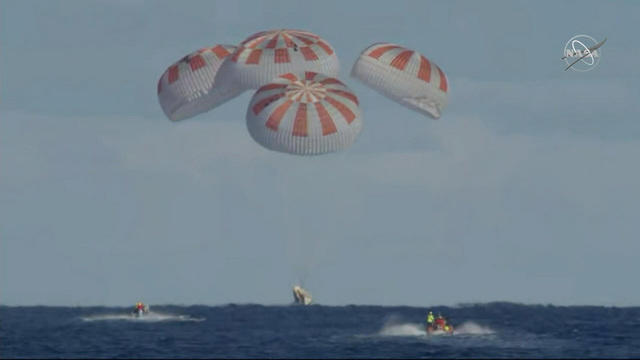SpaceX’s Crew Dragon capsule returned safely to Earth early Friday, wrapping up its inaugural mission to the International Space Station and signaling that the U.S. may soon be able to ferry astronauts to and from space without relying on Russian spacecraft.
The uncrewed capsule splashed down in the Atlantic Ocean, off the east coast of Florida, at 8:45 a.m. ET after spending almost a week at the space station. The spacecraft undocked from the orbiting outpost Friday at 2:32 a.m. ET to begin its descent.
“This is an amazing achievement in American history,” NASA administrator Jim Bridenstine said from the space agency’s Johnson Space Center in Houston. “These are all capabilities that are leading to a day where we are launching American astronauts on American rockets from American soil.”
The Crew Dragon capsule was lofted into orbit March 2 by a SpaceX Falcon 9 rocket from Cape Canaveral, Florida.
The flight was a crucial test of the new spacecraft, a seven-passenger vehicle that SpaceX has been developing for the past five years.
“It’s a great day for the nation, for SpaceX, for NASA — really for the world,” Benjamin Reed, director of commercial crew mission management at SpaceX, said after the capsule’s splashdown was confirmed.
The Hawthorne, California-based company has been flying robotic supply missions to the space station since 2012.
For this mission, the capsule was loaded with 450 pounds of cargo and a spacesuit-clad test dummy named “Ripley” after Ellen Ripley, the fictional character played by Sigourney Weaver in the 1979 film “Alien.”
NASA is expected to schedule one more uncrewed flight of the Crew Dragon capsule to test the spacecraft’s emergency abort system. After that, the space agency could authorize a Crew Dragon flight to the space station with two NASA astronauts onboard.
The U.S. hasn’t had a way to carry humans into orbit since 2011, when NASA retired its space shuttle fleet. Since then, astronauts have flown to and from the space station aboard Russia’s Soyuz capsules mounted atop Soyuz rockets.
To end its reliance on Russia — a situation that many in the spaceflight community considered an embarrassment — NASA in 2014 awarded SpaceX and Boeing a combined $6.8-billion contract to build a pair of spacecraft to fill that gap.
Boeing could conduct the first uncrewed test flight of its CST-100 Starliner capsule as soon as April.








